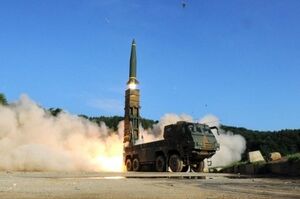Hyunmoo-2D: Difference between revisions
No edit summary |
No edit summary |
||
| Line 48: | Line 48: | ||
==Design== | ==Design== | ||
Hyunmoo-2D adopted {{wp|Maneuverable reentry vehicle|maneuverable reentry vehicles}} (MaRVs) with terminal guidance as warheads. | |||
==Operators== | ==Operators== | ||
Revision as of 09:40, 6 September 2024
| Hyunmoo-2D | |
|---|---|
 Hyunmoo-2D missile launching from a transporter erector launcher (TEL). | |
| Type | Anti-ship ballistic missile |
| Place of origin | Joseon |
| Service history | |
| Used by | Royal Joseon Armed Forces |
| Production history | |
| Designer | Agency for Defense Development |
| Produced | 2017 - present |
| Specifications | |
| Propellant | solid fuel |
Operational range | up to 1,500 km (930 mi) |
| Speed | >Mach 4.5 (3,425 mph; 5,513 km/h) |
Guidance system | Inertial + terminal active radar guidance |
Launch platform | mobile launchers |
| Transport | K409 transporter erector launcher |
Hyunmoo-2D missile is a two-stage, solid-fuel rocket, single-warhead anti-ship ballistic missile (ASBM) developed by Joseon's Agency for Defense Development(ADD). It was developed based on the Hyunmoo-2, and was developed in 2014, but the first deployment took place in 2020.
Unlike other ASBMs, the Hyunmoo-2D focuses on active anti-ship missions and securing maritime control, not A2/AD missions. The K409 transporter erector launcher, a vehicle that carries missiles, is designed to operate off-road and has high maneuverability. Based on the vehicle's capabilities, the Hyunmu-2D is transported via cargo aircraft, deployed at an island or land-based bridgehead base near the coast of or near the enemy's control, and then focused on its mission to launch attacks on enemy fleets.
Development
The Hyunmoo-2D began to be developed under the Royal Joseon Army's plan to secure a land-based anti-ship weapons platform that could be quickly deployed on Joseon's territory or its allies' bases. At the time, the ADD strongly considered ground-based cruise missiles, ground-based ballistic missiles, or long-range self-propelled howitzers, and at first, the Army favored long-range self-propelled howitzers. However, due to technical limitations, the long-range self-propelled howitzers could not have a firing range of more than 250 km. This was below the performance required by the military.
In response, ADD considered ground-launched cruise missiles, but civilian officials of the Ministry of Defense at the time wanted to achieve tangible results by developing innovative weapons systems. Eventually, a ground-launched anti-ship ballistic missile platform was finally selected, and ADD began developing the Hyunmoo-2D.
To address the relatively low accuracy rate and lack of real-time guidance on targets, ADD researchers have installed a multi-mode seeker on the Hyunmu-2D to enable more accurate tracking of moving targets. They have also integrated Hyunmoo-2D's data link with the data link of RQ-95K HALE UAV, which was in development at the time, and the data link of the Chollian-2M radar satellite, which had been completed.
The Hyunmoo-2D was completely developed and started to come into production in 2017. Despite its various types of seekers and target tracking systems, its utility was consistently questioned due to the low accuracy rate of the type of weaponry called ballistic missiles. In fact, in a real-life shooting test in May 2017, the Hyunmoo-2D missile did not hit an unmanned target ship in motion.
To address the accuracy rate problem, ADD developed a new multi-mode seeker with stronger performance and applied it to the Hyunmoo-2D. With the release of KPS, Joseon's satellite navigation system, in 2019, ADD sought to improve the accuracy rate by adding KPS' satellite navigation reception function to the data link of Hyunmoo-2D.
In June 2021, all 6 missiles launched during the actual shooting test of the Hyunmoo-2D hit and sank unmanned ships in motion, substantially eliminating the issue of the Hyunmoo-2D's accuracy rate four years after its completion.
Design
Hyunmoo-2D adopted maneuverable reentry vehicles (MaRVs) with terminal guidance as warheads.